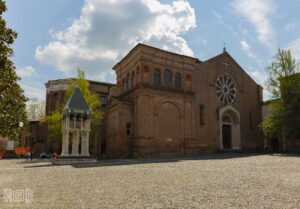Did you know that Bologna houses one of the oldest gardens in Europe? Discover with us the history of the botanical garden and where it is located!
The botanical garden
The botanical garden of Bologna was born in the XVI century with a mainly didactic function; today it is the fourth oldest garden in Europe, after those of Pisa, Padua and Florence.
Its birth is due to the botanist Luca Ghini, who was the first to ask the Bolognese Senate to create a garden, but, due to financial constraints, the request was refused.
It was Ulisse Aldrovandi who carried out the project of his botany master in 1568.
Initially, the botanical garden was located in Palazzo Pubblico (today Palazzo d’Accursio), but due to its small size there was the need to move it first to the Salaborsa Library (discover all its curiosities in the article The Salaborsa Library and its incredible uses over time) and, later, in the Borghetto of San Giuliano (Santo Stefano neighbourhood) in 1587.
Soon even this new location revealed itself too small due to the increase in knowledge about plants: it was thus that the botanical garden returned to its initial residence.

It was only in 1803 that the University of Bologna (see also the article Bologna: the oldest university of the Western world) purchased land between via Irnerio, Porta San Donato and Porta Mascarella, to be dedicated to the establishment of the botanical garden. Even today it is possible to visit it in the same location.
The botanical garden has not always been as luxuriant as it can be admired now: during the Second World War it was abandoned, becoming an overgrown garden.
Only in 1964, thanks to Felice Bertossi, director of the herbarium, was the botanical garden refurbished.
The subdivision of the garden
The botanical garden consists of an area of about 2 hectares in a rectangular shape.
The entrance is located in St. Irnerio 42; entering, you will immediately find the front garden, where you can admire the arboreal plants. Proceeding with the path you arrive at the rear garden, where you can admire the characteristic broadleaved forest, a peculiarity of Bologna.
Continuing on, you can admire the four greenhouses of the botanical garden: the greenhouse of succulent plants, the tropical greenhouse and the two greenhouses of carnivorous plants.

But that’s not all!
In the second part of the garden, you can admire the Garden of the simple, where you will find medicinal plants, the floodplain wood (typical area of the Emilian plain), the pond and the rock garden that houses different types of rocks.
Finally we find the forest. The latter is a reconstruction of the Apennine woods that can be found in the hilly and mountainous areas of Emilia-Romagna.

As we have just seen, the botanical garden is an immense garden, rich of vegetation.
The Herbarium
Inside there is also the Herbarium, an area closed to the public and open only for study and research purposes.
Its history begins around 1551, when Ulisse Aldrovandi decided to observe and study numerous plant species. Thanks to his great work, he managed to create fifteen bound volumes comprising five thousand samples.
Today, thanks to the work done by the CLUEB of Bologna, it is possible to observe all the plants preserved within the volumes on the site of the University Museum System.
The paths inside the botanical garden
To visit and understand better the plants that make up the botanical garden, the University of Bologna has created short itineraries to accompany visitors.
Currently you can choose between the path of alimurgic plants for adults and the treasure hunt for the little ones.
The Alimurgic plants
The route of alimurgic plants involves the observation of eight species, but what is an alimurgic plant?
Alimurgico is a term that refers to edible wild plants, while alimurgia is a word composed of “alimentia” and “urgentia” and is the science that studies the food use of these plants.

In the past, but still today, alimurgic plants were collected and used in the kitchen to provide for the lack of food.
These plants grow in the fields and that is why they are difficult to find in the city; there are various types, from edible to poisonous ones.
During the walk inside the botanical garden, you can see the common caper growing in rocky crevices, on old walls, on limestone sea cliffs, from 0 to 1000 meters.

We continue with the calendula, which arises spontaneously in uncultivated fields and gravel and ruderal meadows, from 0 to 600 meters.
Not to mention the wild spinach, usually observed at the mountain huts, in uncultivated and fertilized places in the mountains, from 500 to 2500 meters. In the mountains we can also find alpine rhubarb.
Returning to the plains, we find the vitalba that grows in hedges, in abandoned walls, in wild places and at the edge of rivers and canals. Borage, on the other hand, is born in fertilized soils and humid ruderal environments.
The last two species that we can find in the botanical garden are the black elder, typical of clearings and the edges of humid woods, and the butcher’s broom, which grows in warm and sunny areas on calcareous soils.
Thus ends the path of alimurgic plants, excellent for those who want to know new species.
For the children
The University of Bologna has also thought of the little ones with a treasure hunt!
To participate, you need a tablet or smartphone, a document that can be downloaded from the botanical garden website and a pen.
Children, along the path to visit the botanical garden, will have to look for the drawing of an acorn with a lens, bring their smartphone closer and scan the QR code. At this point a green writing will appear and only the first letter of the word must be shown in the leaflet, in the stage corresponding to where you are.
At the end of the path, the name of a plant located inside the botanical garden will appear.
But that’s not all!
Once you have found the word, run to the Infopoint, there is a surprise waiting for you!

When can I visit the botanical garden?
The botanical garden can be visited from Tuesday to Sunday, from 10 am to 6 pm in the period from 1 April to 30 September; while from October 1 to 31 March it is possible to visit it from Tuesday to Sunday, from 9 am to 3 pm.
The Garden also offers a lot of activities for the young public, check them out here Museums in Bologna: a must-see heritage. And if you want to make them experiment with cooking, Sfoglia Rina organizes courses for them too! Find out more in the article dedicated to the ancient art of sfogline.
How much does it cost to visit the botanical garden?
Admission is free!
And if after visiting the botanical garden, you start to feel a certain hunger, the area of Quarilatero, with its shops and taverns, will certainly satisfy your palate! Read also our selection of the best 5 inns and taverns in the city!
If you like to be outdoors, do not miss the Sanctuary of Our Lady of San Luca: a place rich in history with a breathtaking view that will not disappoint you! Did you know that the longest porch in the world will take you to San Luca? For more information on the famous arcades of Bologna read our article The arcades of Bologna: UNESCO World Heritage.
We also recommend visiting some of the city’s historical symbols such as The Cathedral of San Pietro, The Two Towers and the Fountain of Neptune, also part of Bologna’s Seven Secrets. Come and discover them with us!
Bibliography:
- Costa T., Bologna dalla A alla Z, Bologna, Costa Editore, 2011.
- Foschi P., Poli M., La Sala Borsa di Bologna, Bologna, Editrice Compositori, 2004.
- Savelli R., L’Orto Botanico di Bologna, Bologna, 1962.
- Tovoli C., Giardini nel tempo. Dal mito alla storia, Bologna, Istituto per i beni artistici, culturali e naturali della Regione Emilia-Romagna, 2015.




